Review GSM phone Siemens CL75
Siemens
CL75. Live pictures
Package:
- Handset
- Battery
- Charger
- Manual
The company of Siemens lost its positions on the majority of world markets in the course of the last year. Its executive stuff tries to change the state and takes various steps in a hurry. And one of such solutions was widening the model line with devices never represented in the line before, niche devices. In the majority of cases time shortage tells negatively on model completeness. And a women phone Siemens CL75 belongs to such category. This handset can be considered the second phone of the middle segment targeted at women (the CL index). Some time ago Siemens CL50 failed to reach considerable sale and became an assortment model. And the task of Siemens CL75 was similar - assortment support. Nobody even thought it might have been interesting on the market and would have high sale rates. As a result, investments into development and testing were minimal, and now let us speak about it all in order.


The phone design is the most close to Asian products (and precisely this design is not developed in Siemens): round body shape, the appearance of the objective, and other elements. Externally the handset rose moderate interest, girls' estimations really varied. But even appreciations were cool. That's why selecting a phone as a gift, you should remember to as if your girl likes the model, when you are not sure.
Two colours are available - black and red. The first case shows the front panel with a partly black insertion with silvery lines, and the back looks the same way. The second variant represents pictures of flowers, which looks more interesting. Interchangeable panels are not supported, which is typical of this class.
And if the size (87x44x23 mm) suits average value for this class in general, then its thickness and the absence of a hollow on side surfaces prevent from opening it with one hand carelessly. You will have to use your second hand and hock a small rest with your nail. When opening the handset, your finger will surely slide along the internal screen.

The weight of 90 grams makes no problems. The strap hole is implemented in the same manner as in the previous models by the company - a strap is passed though the back cover. On a girl's breast the device will be turned over, so that a Siemens inscription will be shows upside-down.
The front panel features an external screen of 96x64 pixels showing 65K colours (STN). In the standby mode you will see time and status icons on it. The quality o the picture is middling on the screen and badly read in the sun. We can't consider this screen comfortable due to small physical size (20x14 mm), the quality of shown colours more corresponds with 4096 and is comparable with screens of the first generation. While shooting, you can use the external screen as a viewfinder.


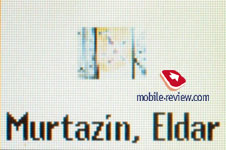
The camera objective is placed in the bottom part of the front panel; its mirror edging is too thin to be considered a mirror, which is more a decorative element. A camera module differs from the ones used in the 75th series devices, which is quite logical.


The bottom end features an interface connector coinciding with the one for the 75th series, which confuses many people considering accessories. Even if a headset will work with this device, a USB cable (510th) won't - only DCA-500 will suite, but even it seems useless due to the phone restrictions.
Two buttons found room on the right side - that is a camera button and a speakerphone button below (Push to Talk is absent despite it was planned earlier). Volume buttons are placed on the opposite side, and they can help activating backlighting for the external screen.

An IrDA gap is placed on the right side. This wireless technology is the main mean for communicating with the world for the CL75. And the more problems when it goes wrong are. There are only several devices Siemens CL75 can connect to (for instance, Sony Ericsson K750 doesn't work with it at all). Very funny situations happen when exchanging data with Siemens products, and namely the 75th series. Truly, we managed to establish connection after several attempts and got the worst impression. High speed of the port, which Siemens' worshipers admire so much, means nothing due to its poor compatibility with the majority of represented products. This phone lacks the corporate Siemens' feature - a capability to upload Java applications via IrDA or a cable, you can only use wap for it. A file transmitted via IrDA is limited to 350 KB, which sometimes hinders from sending clips created o a PC.

The internal screen uses a mirror mat; all the makers producing women phones try to copy this peculiarity of Samsung T500. However, the absence of personal technologies only makes such attempts unsuccessful and the Cl75 proves it again. The distance between the screen and the mat is too big, which results in the duality of the picture at certain angles and lighting conditions. However this problem is not very serious, sometimes fonts see double, extra reflection appears. Too many technological tolerances are made. Even in Samsung T500 we saw no similar problems (the first screen of this kind).

A special button activates the mirror, which is a central point in the promotion of the device. Despite frequent flares, the screen is well read in the sun due to the mirror covering. This phone greatly differs from other 75th series representatives with a mirror layer in the screen. Behaviour in the sun is much worse; indoors it is also imperfect (worse than in Siemens CX75). The manufacturer claims 262K colours; however, it seems it shows not more than 65K. The resolution of the screen is 128x160 pixels (TFT, 28x35 mm), which allows up to 7 text lines and two service lines. The quality of the picture on the screen is not very good, and rouses negative impression in combination with rude interface drawing.

The keypad is of black lacquered plastic, each key is rounded with a chromium-plated edging. At the same time a perfect combination with this is reached due chromium-plated functional keys and a navi button. The keypad is the strength of the phone. It looks perfect and tactile feelings are wonderful. The buttons are backlit in blue; this backlighting is in pale blue and well-seen only in complete darkness.


A 750mAh Li-Ion battery hides behind the back panel. According to the manufacturer, the device is capable of up to 200 hours in the standby mode and up to 3 hours of talks. Complete recharging requires about 3 hours.
Under the condition of Moscow networks the phone worked for averagely 3 days in case of 25 minutes of talks and minimum of using other functions. Using IrDA constantly, you will have the handset lasting for only a day. Ones traveling by tube will have to humble with seriously shortened battery life (about 40 percent of the given results, which depends on the frequency of your trips). The phone spends much of the charge at reregistering in the network, and correspondingly, the more frequently your device loses network, the less it works. Your obedient servant forgot to turn the phone off during a short flight and left it in a bag. It got completely drained in two hours.
Menu
The phone interface was completely redesigned to correspond with other Siemens' products (however, these improvements seem dubious for icons look awfully). Pressing Ok you get into the main menu. And traditionally the menu is represented with a 3x4 matrix and allows fast navigation using number sequences. You can assign own functions to number keys, and functions for both soft-keys are also selectable. And we will finish it with a capability to assign functions to three directions of the navi button (pressing down you will always call the phonebook).

The phone has a memory bank of 12627 KB, and 11 MB of them are available primordially. Memory is dynamically shared between all applications. A real disadvantage is a user can't upload his pictures, melodies and applications to the phone directly by requesting the phone memory. The handset will distribute the content among corresponding folders by its own (if it recognizes the format of the received file). In difference to other 75th series devices this handset shows no icon at receiving a file, you will have to go to "Other" and Data Inbox folders and extract the files (which is extremely uncomfortable when receiving a visit card).
Phonebook. Up to 500 names are storable in the phone memory. At that such fields as Name, Surname, Phone number, Mobile, Personal address, Area code, City, Country, E-mail address, Company name, all fields for a work address, site URL, a note, birthday, Users' group personal melody, and a picture are specified. It would seem that no peculiarities are possible, and the realization is on the level of other phones by Siemens, but that is wrong.
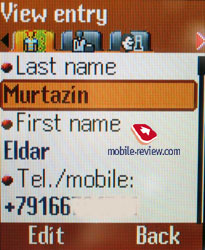


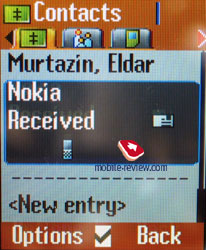


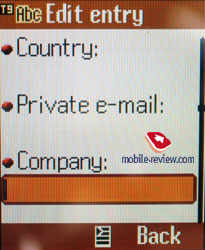


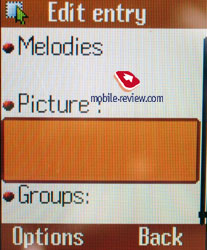
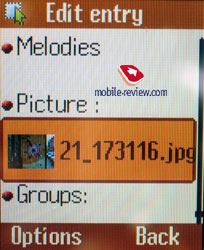

First, the general list shows both SIM-card notes and entries of the phone memory; you can't select only one memory type. You will have to kick your habit if you are used to storing a copy of entries on a SIM.
Second, receiving entries fro other devices is sometimes incorrect, they are not distributed along necessary fields and the same concerns synchronization with MS Outlook. Sometimes some fields are lost at transfer.
Third, the phone has no clue of which format a number should be entered in. For instance, having entered only 7 digits without a prefix, you can't have user's name defined as well as the type of the number at incoming call. Also you can't enter 8916xxx-xxxx since the phone doesn't understand this format either. This causes problems for some networks, where the network may provide a number in this form at a call. You need to enter numbers to the phonebook in international format. I won't judge how comfortable that is, but seems to discipline surely. The trick is in messages names are detected only without an international prefix, so you will have to decide where it is most important to see a user's name - in the phonebook or in messages, since together they can't work correctly.
Fourth, when selecting a number for fast dial of the three numbers stored for a name, you can point any you need. But the function will work only if you select the first one, which is also a default number.
Totally the device offers 9 users' groups with a capability to set a personal melody and picture for each. At incoming call a picture is shown on the external screen, and it is really miniature, since even a man with great imagination will not recognize a pictured person. You should better take a photo of some colour, and then it is possible to understand what is on the screen.
A phonebook entry is organized very plainly. There are three tags you move along. The first one contains a surname and a name, the second is divided to extra information and the third one shows a picture and a melody selected for a user. Unfortunately, the phone doesn't show the photo selected, you can only view it from the editing menu, which really tires.
At incoming calls a name is shortened to 13 characters, and not more, at the same time scrolling is absent.

Call lists. Each list contains up to 10 numbers, a comfortable thing is you can move using separate bookmarks (made, received and missed). No total call list is foreseen. Date and time are specified in call details and calls from the same number are not summed up, and are shown separately.


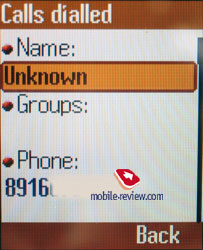
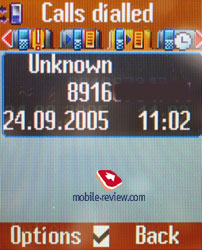
Messages. The device has a memory bank for 100 messages and traditionally received ones can be stored in an archive. EMS standard is supported, and a typical of Siemens set of icons is provided. Text templates can be created, and T9 predictive text input is provided.

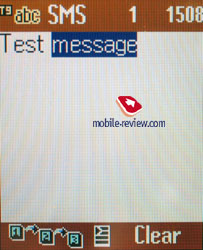
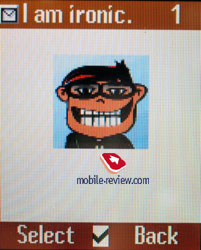
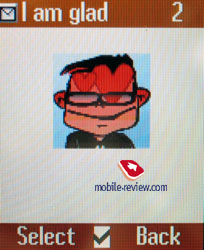
MMS standard is also provided, it shows no peculiarities, settings are rather flexible, despite preset templates are absent, you can create own ones. A restriction to 300 KB per a message can't be changed.

Alarm clock. The device offers four alarm clocks, and each can be set for a certain week-day. No other peculiarities.

Organizer. Calendar shows a month, and days with saved events are emphasized with colour. Also you can view a weekly calendar with a time grid. Organizer entries can be of various types, and you can set alert and recurrence for them. An advantage is a capability to set a dictaphone entry as an alarm signal. Up to 500 entries are possible.
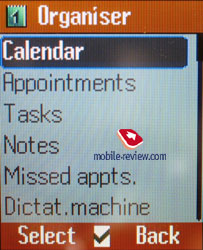
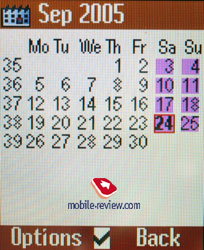

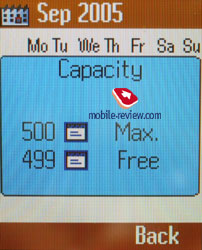


Various priorities are possible in a to-do list, also voice memos are supported.
The device is fully synchronized with MS Outlook.
This section also contains a world time function, no peculiarities.

Works only in the standby mode, a recorded file is AMR not longer than three and a half minutes. You can use records as a call signal.


Extra. This menu contains a calculator (expanded mode is provided as well), unit converter, a special utility for recording sounds (no difference with the dictaphone, except for the name), a stopwatch (two intermediate results are possible), and a countdown timer. You can set tags for the most frequently used functions in Favourities.






WAP. Wap browser version 2.0 is preinstalled, it works badly and unstably. Mainly phone restarts were caused by working with a wasp-browser, we failed find an explanation.

Gamesры. The first game is a typical arcade, the second one is some kind of Tamagotchi for adults where you have to live a successful life, including flirting with other gamers via SMS.

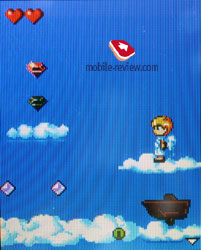
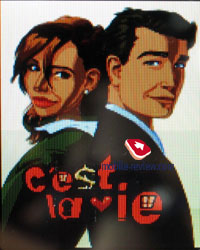

Settings. The device provides profiles, which you can adjust by your wish; you can select a diapason (you should better keep automatic), menu colour settings, and themes. No secrets and everything is traditional.
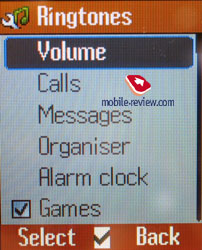


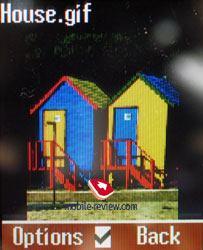


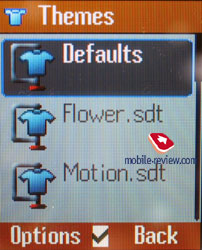
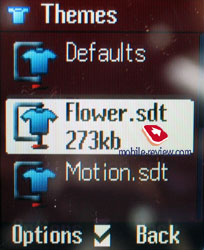
Camera. The phone comes equipped with a VGA camera, and the manufacturer preferred specifying names like Premium (640 x 480), high, and medium to picture resolution. Other settings allow selecting a default name for files, in particular it may contain the current date and time (these are templates). White balance may be either automatic or manual (street, home).


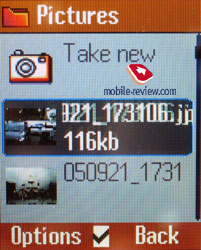

Phone screen serves as a viewfinder, at sharp motion the picture almost doesn't come off. Received photos look acceptably on the screen. There is a timer for self portrait.
You can tune brightness in one touch and use digital zoom. The handset also allows recording video with sound. Clips look acceptably but not more.
The photos received can be used as you like, even send to other devices via IrDA.
Siemens CL75
|
 |
 |
(+)
increase, 640x480, JPEG |
(+)
increase, 640x480, JPEG |
 |
 |
(+)
increase, 640x480, JPEG |
(+)
increase, 640x480, JPEG |
 |
 |
(+)
increase, 640x480, JPEG |
(+)
increase, 640x480, JPEG |
 |
 |
(+)
increase, 640x480, JPEG |
(+)
increase, 640x480, JPEG |
Video sample 1 (3GP, 131 KB)
Video sample 2 (3GP, 131 KB)
Productivity. We tested the phone with all the three versions of the test package, and below we provide the results. Also we should mention that a 3D package doesn't run on the device, Java realization doesn't foresee processing corresponding programs. Take it into consideration.
Jbenchmark 1
Version 1.1.1
Total Score: 1123
Details:
Text 291
2D Shapes 278
3D Shapes 196
Fill Rate 118
Animation 240
Screen Width 128
Screen Height 142
Color Screen true
Number of Colors 65536
Double Buffer true
Total Memory 1228736
Free Memory 147360
MicroEdition Configuration CLDC-1.1
MicroEdition Profiles: MIDP 2.0
Microedition Platform: Jbed
Microedition Encoding: ISO-8859-1
Microedition Locale en
Jbenchmark 2
Version 2.1.1
Total Score: 63
Details:
Image Manipulation 64
Text 76
Sprites 144
3D Transform 34
User Interface 39
Screen (canvas) Width 128
Screen (canvas) Height 142
Color Screen true
Number of Colors 65536
JPEG Support 2
Transparency (Alpha Level) true
Double Buffer true
Total Memory 1228736
Free Memory 353536
MicroEdition Configuration CLDC-1.1
MicroEdition Profiles: MIDP 2.0
Microedition Platform: Jbed
Microedition Encoding: ISO-8859-1
Microedition Locale en
Phone productivity is lower than in the 75th series by Siemens. You will surely notice this slow down in loading and working with applications.
Synchronization with PC. Although Mobile Phone Manager is not included into the kit, you can upload it, and despite the majority of the functions will not be available, you still will be able to synchronize data with MS Outlook. The absence of fully functional synchronization of pictures, melodies and access to the internal memory shows the platform is alien to the 75th series.
Impressions
The volume of the 40-tones polyphonic alert is enough for hearing the device in the street. MP3 files and AAC are not supported, which makes the phone rather outdated. So you should use either SMAF or MIDI files. And considering that the majority of phones in this class have no similar limits, we surely assign it to drawbacks. The power of a vibracall is average, sometimes it is not felt from the clothes pocket, and carrying the phone on the body, you will feel it well.
When you scroll lists with audio files, they start playing automatically, which is not good sometimes. This peculiarity is rather untypical of Siemens.
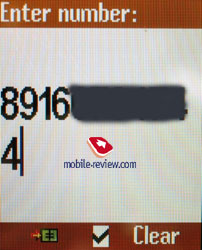



When working, we experienced frequent restarts for unknown reasons besides described above problems. We should refer it to software peculiarities.
The model is not interesting for its general characteristics. The presence of the mirror for the internal screen seems dubious advantage, and the majority of functions is realized badly, we mean the phonebook and IrDA. That seems the developers consider that an assortment model doesn't have to be functional and capable of work. Also the company doesn't plan to complete the software and the platform to stable work considering forecasts of low sales by all distributors. That is a temporary solution for some time.
Now the price for the model is 240-250 USD, which is too much for a raw solution of the previous generation. No fashion component present makes this phone even less attractive. Even Siemens' worshipers won't be pleased with the model, since the functions that this company is famous for are cut here. This phone is obviously close to the products of the third echelon makers. I see no reason for buying it due to such quality of software and problems described below.
The SAR value for this model is 0.66 w/kg.
Eldar Murtazin (eldar@mobile-review.com)
Translated by Maria Mitina (maria.mitina@mobile-review.com)
Published — 7 November 2005
Have something to add?! Write us... eldar@mobile-review.com
|

















































































